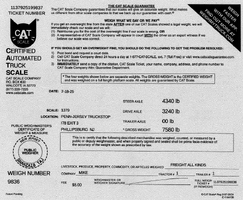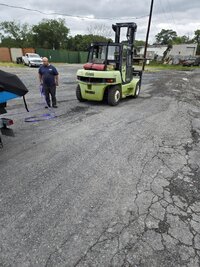Emptytemples
Jetboaters Lieutenant
- Messages
- 137
- Reaction score
- 138
- Points
- 152
- Location
- Easton, PA & Ocean City, MD
- Boat Make
- Yamaha
- Year
- 2023
- Boat Model
- AR
- Boat Length
- 25
opening this thread to show my boats weight from a CAT scale. I was thinking about doing the same or possibly trying to tow every once in a while with a Durango that we may get. Same engine and towing capacity as the Grand Cherokee with a V6. Here's what i've heard and my .02. I want to be roughly 10% under the tow capacity on any trip over an hour drive. Most of my trips are 200 miles when towing so that was important. I already have a tow vehicle, 2016 F250 but that is getting older and considering replacing that with a new or newer half ton or 3/4 ton truck later this year. The Durango would only be used in a pinch or seldomly as it has more room if we bring the dog blah blah blah. We test drove the hemi version which has payload in the 7200 range I believe. IS the only difference the engine? Are there upgraded driveshafts, fans, suspension, etc etc to get you an extra 1000lbs? Likely not but some person that knows more about Dodge can enlighten me. Anyway, we have a 2023 AR250 so the boat is a little lighter than the higher trim models. No fresh water tank, I only have 2 batteries, no tower speakers, etc. We have a couple of anchors, some pop up chairs, tables, potty, some odds and ends but nothing crazy. Boat has about 15-20 gallons of fuel? ?


So what did I take away from this? Well for starters I thought maybe my tongue weight was a bit high at roughly 920lbs. I was hoping for closer to 600lbs tongue weight. It removed 240lbs from my steer axle. Not a big deal on the truck but it might affect the suvs a bit more. Also that is right at the 90% towing capacity of the 6200lb towing class vehicles. Also, as mentioned, most of these vehicles, 6 cylinder n/a, with turbos, 8cyl etc have plenty of power to pull the boat. Its braking at 13,000lbs, giving sufficient space, and paying attention around you that are more significant. I see too many people on the phone anymore and it is quite alarming. Anyway, thought I'd share my scale tickets as i don't remember seeing them before but could have easily missed a previous post.
Happy Towing (and boating)


So what did I take away from this? Well for starters I thought maybe my tongue weight was a bit high at roughly 920lbs. I was hoping for closer to 600lbs tongue weight. It removed 240lbs from my steer axle. Not a big deal on the truck but it might affect the suvs a bit more. Also that is right at the 90% towing capacity of the 6200lb towing class vehicles. Also, as mentioned, most of these vehicles, 6 cylinder n/a, with turbos, 8cyl etc have plenty of power to pull the boat. Its braking at 13,000lbs, giving sufficient space, and paying attention around you that are more significant. I see too many people on the phone anymore and it is quite alarming. Anyway, thought I'd share my scale tickets as i don't remember seeing them before but could have easily missed a previous post.
Happy Towing (and boating)

